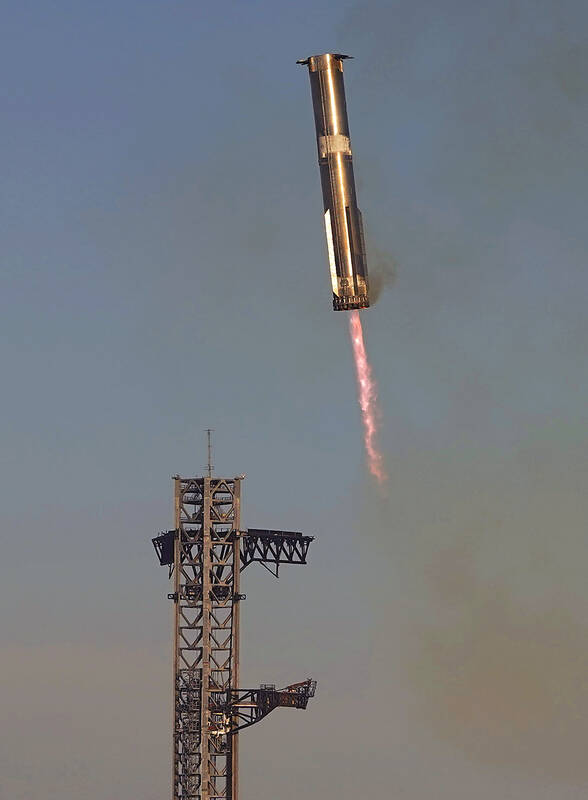SpaceX launched its Starship rocket on its latest test flight on Thursday, but the spacecraft was destroyed following a thrilling booster catch back at the pad.
Elon Musk’s company said Starship broke apart — what it called a “rapid unscheduled disassembly.”
The spacecraft’s six engines appeared to shut down one by one during ascent, with contact lost just eight-and-a-half minutes into the flight.

Photo: AP
The spacecraft — a new and upgraded model making its debut — was supposed to soar across the Gulf of Mexico from Texas on a near loop around the world similar to previous test flights. SpaceX had packed it with 10 dummy satellites for practice at releasing them.
A minute before the loss, SpaceX used the launch tower’s giant mechanical arms to catch the returning booster, a feat achieved only once before. The descending booster hovered over the launch pad before being gripped by the pair of arms dubbed chopsticks.
The thrill of the catch quickly turned into disappointment for not only the company, but the crowds gathered along the southern tip of Texas.
“It was great to see a booster come down, but we are obviously bummed out about ship,” SpaceX spokesman Dan Huot said.
“It’s a flight test. It’s an experimental vehicle,” he stressed.
The last data received from the spacecraft indicated an altitude of 146km and a velocity of 21,317kph.
Musk said a preliminary analysis suggests leaking fuel might have built up pressure in a cavity above the engine firewall.
Fire suppression will be added to the area, with increased venting and double-checking for leaks, he wrote on X.
The 123m rocket had thundered away in late afternoon from Boca Chica Beach near the Mexican border. The late hour ensured a daylight entry halfway around the world in the Indian Ocean, but the shiny retro-looking spacecraft never got that far.
SpaceX had made improvements to the spacecraft for the latest demo and added a fleet of satellite mockups. The test satellites were the same size as SpaceX’s Starlink Internet satellites and, like the spacecraft, were meant to be destroyed upon entry.
Musk plans to launch actual Starlinks on Starships before moving on to other satellites and, eventually, crews. It was the seventh test flight for the world’s biggest and most powerful rocket.
NASA has reserved a pair of Starships to land astronauts on the moon later this decade. Musk’s goal is Mars.
Hours earlier in Florida, another billionaire’s rocket company — Jeff Bezos’ Blue Origin — launched the newest supersized rocket, New Glenn. The rocket reached orbit on its first flight, successfully placing an experimental satellite thousands of kilometers above Earth. However, the first-stage booster was destroyed, missing its targeted landing on a floating platform in the Atlantic.

Kehinde Sanni spends his days smoothing out dents and repainting scratched bumpers in a modest autobody shop in Lagos. He has never left Nigeria, yet he speaks glowingly of Burkina Faso military leader Ibrahim Traore. “Nigeria needs someone like Ibrahim Traore of Burkina Faso. He is doing well for his country,” Sanni said. His admiration is shaped by a steady stream of viral videos, memes and social media posts — many misleading or outright false — portraying Traore as a fearless reformer who defied Western powers and reclaimed his country’s dignity. The Burkinabe strongman swept into power following a coup in September 2022

‘FRAGMENTING’: British politics have for a long time been dominated by the Labor Party and the Tories, but polls suggest that Reform now poses a significant challenge Hard-right upstarts Reform UK snatched a parliamentary seat from British Prime Minister Keir Starmer’s Labor Party yesterday in local elections that dealt a blow to the UK’s two establishment parties. Reform, led by anti-immigrant firebrand Nigel Farage, won the by-election in Runcorn and Helsby in northwest England by just six votes, as it picked up gains in other localities, including one mayoralty. The group’s strong showing continues momentum it built up at last year’s general election and appears to confirm a trend that the UK is entering an era of multi-party politics. “For the movement, for the party it’s a very, very big

ENTERTAINMENT: Rio officials have a history of organizing massive concerts on Copacabana Beach, with Madonna’s show drawing about 1.6 million fans last year Lady Gaga on Saturday night gave a free concert in front of 2 million fans who poured onto Copacabana Beach in Rio de Janeiro for the biggest show of her career. “Tonight, we’re making history... Thank you for making history with me,” Lady Gaga told a screaming crowd. The Mother Monster, as she is known, started the show at about 10:10pm local time with her 2011 song Bloody Mary. Cries of joy rose from the tightly packed fans who sang and danced shoulder-to-shoulder on the vast stretch of sand. Concert organizers said 2.1 million people attended the show. Lady Gaga

SUPPORT: The Australian prime minister promised to back Kyiv against Russia’s invasion, saying: ‘That’s my government’s position. It was yesterday. It still is’ Left-leaning Australian Prime Minister Anthony Albanese yesterday basked in his landslide election win, promising a “disciplined, orderly” government to confront cost-of-living pain and tariff turmoil. People clapped as the 62-year-old and his fiancee, Jodie Haydon, who visited his old inner Sydney haunt, Cafe Italia, surrounded by a crowd of jostling photographers and journalists. Albanese’s Labor Party is on course to win at least 83 seats in the 150-member parliament, partial results showed. Opposition leader Peter Dutton’s conservative Liberal-National coalition had just 38 seats, and other parties 12. Another 17 seats were still in doubt. “We will be a disciplined, orderly